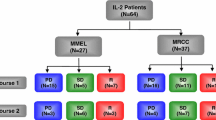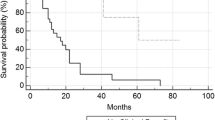Abstract
Background
Preprocedure clinical and pathologic factors have failed to consistently differentiate complete response (CR) from progressive disease (PD) in patients after isolated limb infusion (ILI) with melphalan for unresectable in-transit extremity melanoma.
Methods
Multiplex immunobead assay technology (Milliplex MAP Human Cytokine/Chemokine Magnetic Bead Panel, Millipore Corp., Billerica, MA; and Magpix analytical test instrument, Luminex Corp., Austin, TX) was performed on pre-ILI plasma to determine concentrations of selected cytokines (MIP-1α, IL-1Rα, IP-10, IL-1β, IL-1α, MCP-1, IL-6, IL-17, EGF, IL-12p40, VEGF, GM-CSF, and MIP-1β) on a subset of patients (n = 180) who experienced CR (n = 23) or PD (n = 24) after ILI. Plasma from normal donors (n = 12) was also evaluated.
Results
Of 180 ILIs performed, 28 % (95 % confidence interval 22–35, n = 50) experienced a CR, 14 % (n = 25) experienced a partial response, 11 % (n = 21) had stable disease, 34 % (n = 61) had PD, and 13 % (n = 23) were not evaluable for response. Tumor characteristics and pharmacokinetics appeared similar between CR (n = 23) and PD (n = 24) patients who underwent cytokine analysis. Although there were no differences in cytokine levels between CR and PD patients, there were differences between the melanoma patients and controls. MIP-1α, IL-1Rα, IL-1β, IL-1α, IL-17, EGF, IL-12p40, VEGF, GM-CSF, and MIP-1β were significantly higher in normal controls compared to melanoma patients, while IP-10 was lower (p < 0.001) in controls compared to melanoma patients.
Conclusions
Patients with unresectable in-transit melanoma appear to have markedly decreased levels of immune activating cytokines compared to normal healthy controls. This further supports a potential role for immune-targeted therapies and immune monitoring in patients with regionally advanced melanoma.




Similar content being viewed by others
References
Pawlik TW, Ross MI, Johnson MM, et al. Predictors and natural history of in-transit melanoma after sentinel lymphadenectomy. Ann Surg Oncol. 2005;11:1612–61.
van Poll D, Thompson JF, McKinnon JG, et al. A sentinel node biopsy procedure does not increase the incidence of in-transit recurrence in patients with primary melanoma. Ann Surg Oncol. 2005;12:597–608.
Raymond AK, Beasley GM, Broadwater G, et al. Current trends in regional therapy for melanoma: lessons learned from 225 regional chemotherapy treatments between 1995 and 2010 at a single institution. J Am Coll Surg. 2011;213:306–16.
Beasley GM, Caudle A, Petersen RP, et al. A multi-institutional experience of isolated limb infusion: defining response and toxicity in the United States. J Am Coll Surg. 2009;208:706–16.
Lindner P, Doubrovsky A, Kam PCA, et al. Prognostic factors after isolated limb infusion with cytotoxic agents for melanoma. Ann Surg Oncol. 2002;9:127–36.
Kroon HM, Moncrieff M, Kam PCA, et al. Outcomes following isolated limb infusion for melanoma: a 14-year experience. Ann Surg Oncol. 2008;15:3003–13.
Beasley GM, Petersen RP, Yoo JS, et al. Isolated limb infusion for in-transit malignant melanoma of the extremity: a well tolerated but less effective alternative to hyperthermic isolated limb perfusion. Ann Surg Oncol. 2008;15:2195–205.
Thompson JF, Hunt JA, Shannon KF, et al. Frequency and duration of remission after isolated limb perfusion for melanoma. Arch Surg. 1997;132:903–7.
Augustine CK, Jung SH, Sohn I, et al. Gene expression signatures as a guide to treatment strategies for in-transit metastatic melanoma. Mol Cancer Therapy. 2010;9:779–90.
Hong M, Puaux AL, Huang C, et al. Chemotherapy induces intratumoral expression of chemokines in cutaneous melanoma, favoring T cell infiltration and tumor control. Cancer Res. 2011;71:6997.
Sznol M. Molecular markers of response to treatment for melanoma. Cancer J. 2011;17:127–33.
Boni A, Cogdill AP, Dang P, et al. Selective BRAFV600E inhibition enhances T-cell recognition of melanoma without affecting lymphocyte function. Cancer Res. 2010;70:5213–9.
Galluzzi L, Senovilla L, Zitvogel L, et al. The secret ally: immunostimulation by anticancer drugs. Nat Rev Drug Discov. 2012;11:215–33.
Nardin A, Wong WC, Tow C, et al. Dacarbazine promotes stromal remodeling and lymphocyte infiltration in cutaneous melanoma lesions. J Invest Dermatol. 2011;131:1896–905.
Donepudi M, Jovasevic VM, Raychaudhuri P, Mokyr MB. Melphalan-induced up-regulation of B7-1 surface expression on normal splenic B cells. Cancer Immunol Immunother. 2003;52:162–70.
Sabatino M, Kim-Schulze S, Panelli MC, et al. Serum vascular endothelial growth factor and fibronectin predict clinical response to high-dose interleukin-2 therapy. J Clin Oncol. 2009;27:2645–52.
Yurkovetsky ZR, Kirkwood JM, Edington HD, et al. Multiplex analysis of serum cytokines in melanoma patients treated with interferon-alpha 2b. Clin Cancer Res. 2007;13:2422–28.
Balch CM, Gershenwald JE, Soong SJ, et al. Final version of 2009 AJCC melanoma staging and classification. J Clin Oncol. 2009;27:6199–206.
Therasse P, Arbuck SG, Eisenhauer EA, et al. New guidelines to evaluate the response to treatment in solid tumors. J Natl Cancer Inst. 2000;92:205–16.
McMahon N, Cheng TY, Beasley GM, et al. Optimizing melphalan pharmacokinetics in regional melanoma therapy: does correcting for ideal body weight alter regional response or toxicity? Ann Surg Oncol. Apr. 2009;16:953–61.
Beasley GM, Riboh JC, Augustine CK, et al. A prospective multi-center phase II trial of systemic ADH-1 in combination with melphalan via isolated limb infusion (M-ILI) in patients with advanced extremity melanoma. J Clin Oncol. 2011;29:1210–5.
Beasley GM, Coleman AP, McMahon N, et al. A phase I multi-institutional study of systemic sorafenib in conjunction with regional melphalan for in-transit melanoma of the extremity. Ann Surg Oncol. 2012;19:3896–905.
Ehrsson H, Eksborg S, Lindfors A. Quantitative determination of melphalan in plasma by liquid chromatography after derivatization with N-acetylcysteine. J Chromatogr. 1986;380:220.
Freedman JA, Tyler DS, Nevins JR, Augustine CK. Use of gene expression and pathway signatures to characterize the complexity of human melanoma. Am J Pathol. 2011;178:2513–22.
Yao KA, Hsueh EC, Essner R, et al. Is sentinel lymph node mapping indicated for isolated local and in-transit recurrent melanoma? Ann Surg. 2003;238:743–7.
Tjin EP, Konijnenberg D, Krebbers G, et al. T cell immune function in tumor, skin and peripheral blood of advanced stage melanoma patients: implications for immunotherapy. Clin Cancer Res. 2011;17:5736–47.
Balachandran VP, Cavnar MJ, Zeng S, et al. Imatinib potentiates antitumor T cell responses in gastrointestinal stromal tumor through the inhibition of Ido. Nat Med. 2011;17:1094–100.
Rivoltini L, Carrabba M, Huber V, et al. Immunity to cancer: attack and escape in T lymphocyte–tumor cell interaction. Immunol Rev. 2002;188:97–113.
Harlin H, Meng Y, Peterson AC, et al. Chemokine expression in melanoma metastases associated with CD8+ T-cell recruitment. Cancer Res. 2009;69:3077–85.
Erdag G, Schaefer JT, Smolkin ME, et al. Immunotype and immunohistologic characteristics of tumor-infiltrating immune cells are associated with clinical outcome in metastatic melanoma. Cancer Res. 2012;72:1070–80.
Obeid M, Tesniere A, Ghiringhelli F, et al. Calreticulin exposure dictates the immunogenicity of cancer cell death. Nat Med. 2007;13:54–61.
Acknowledgment
Supported in part by T32 Grant CA093245-10 from NIH (G.M.B.) and Duke Translational Research Institute CTSA Grant (UL1RR024128). The ADH-1 trial was supported by a grant from Adherex Technologies, Inc. Bayer Healthcare Pharmaceuticals provided study drug (sorafenib, Nexavar) for the phase I trial of systemic sorafenib and regional melphalan. D.S.T. is on the speaker’s bureau of Novartis, has been a Scientific Advisory Board Member for Roche/Genetech, and has received clinical trial support from Merck/ScheringPlough Corporation.
Author information
Authors and Affiliations
Corresponding author
Additional information
The first two authors contributed equally to this work, and both should be considered first author.
Rights and permissions
About this article
Cite this article
Shetty, G., Beasley, G.M., Sparks, S. et al. Plasma Cytokine Analysis in Patients with Advanced Extremity Melanoma Undergoing Isolated Limb Infusion. Ann Surg Oncol 20, 1128–1135 (2013). https://doi.org/10.1245/s10434-012-2785-5
Received:
Published:
Issue Date:
DOI: https://doi.org/10.1245/s10434-012-2785-5




